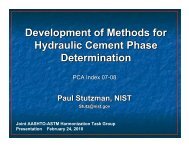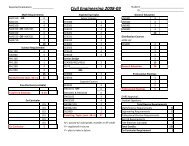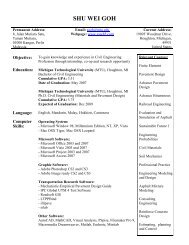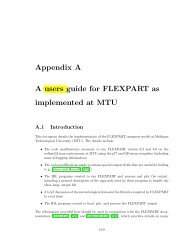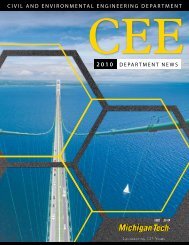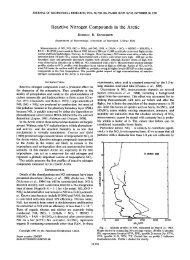Evaluation of Septic Tank and Subsurface Wetland for
Evaluation of Septic Tank and Subsurface Wetland for
Evaluation of Septic Tank and Subsurface Wetland for
Create successful ePaper yourself
Turn your PDF publications into a flip-book with our unique Google optimized e-Paper software.
<strong>Subsurface</strong> Flow Constructed Wetl<strong>and</strong>s<br />
A constructed wetl<strong>and</strong> is a simulated natural environment <strong>for</strong> the filtration <strong>and</strong> biological<br />
treatment <strong>of</strong> wastewater. Horizontal subsurface flow (SSF) wetl<strong>and</strong>s are shallow beds<br />
filled with rocks <strong>and</strong> are usually planted with aquatic vegetation (see Figure 2-3). They<br />
are designed to keep the liquid level 3 to 4 inches below the surface <strong>of</strong> the rock media to<br />
prevent public exposure to the wastewater <strong>and</strong> mosquito breeding.<br />
Figure 2-3 Side view <strong>of</strong> a horizontal subsurface flow wetl<strong>and</strong> showing vegetation.<br />
(Illustration by Cooper, 1993. Republished with permission.)<br />
SSF wetl<strong>and</strong>s are a widely accepted technology <strong>for</strong> reducing wastewater BOD, TSS <strong>and</strong><br />
coli<strong>for</strong>m (Crites et al., 1998; USEPA, 2000; Reed et al., 2001). Several mathematical<br />
models are available <strong>for</strong> calculating the wetl<strong>and</strong> surface area or volume necessary to<br />
achieve the required BOD <strong>and</strong> nitrogen removal. TSS treatment follows closely with<br />
BOD removal so that designing <strong>for</strong> BOD parameters will provide sufficient treatment to<br />
meet similar TSS treatment st<strong>and</strong>ards (Reed et al., 2001). According to one authority, a<br />
wetl<strong>and</strong> designed with 6-10 day HRT, BOD mass load below 100 lb/ac-d (89 kg/ha-d)<br />
<strong>and</strong> influent nitrogen below 25 mg/l should meet effluent st<strong>and</strong>ards <strong>of</strong> 20 mg/l BOD, 20<br />
mg/l TSS <strong>and</strong> 10 mg/l N (Crites et al., 1998). Removal efficiencies based on inflow <strong>and</strong><br />
outflow concentrations through horizontal SSF wetl<strong>and</strong>s in Europe <strong>and</strong> North America<br />
10



